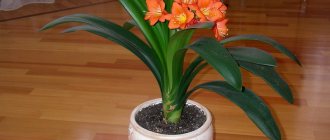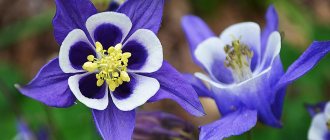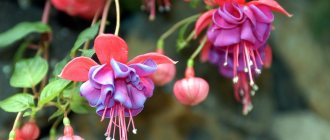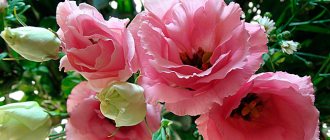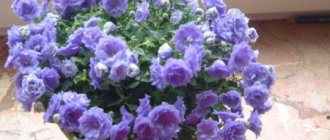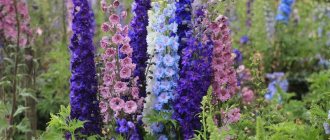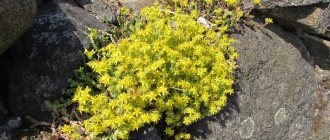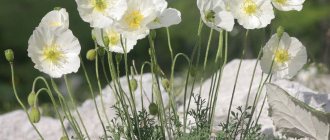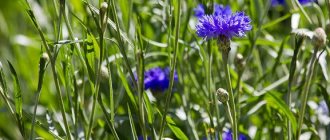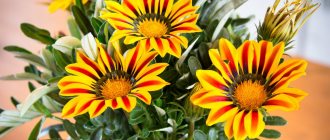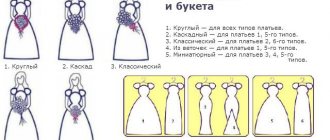Types of delphinium
Delphiniums are perennial and annual plants of the Ranunculaceae family. There are many varieties of delphiniums. Depending on them, they can be tall, up to three meters, and very tiny, only 10 cm.
Delphiniums are loved for their beautiful inflorescences, in the form of a panicle or brush. A panicle can have from 3 to 15 flowers. And in the inflorescence-brush there are from 50 to 80 simple or double flowers.
The more flowers are located along the axis of the stem, the more perfect the variety is considered. The density of flowers and their doubleness are also appreciated.
Delphiniums look especially impressive among other perennials, so they are used in various flower beds, mainly multi-level elongated ones. According to the timing, perennial and annual plants are distinguished. Annuals are considered easier to grow. The most popular among them are the field delphinium and the Ajax delphinium.
Delphinium Consolida
Delphinium arvensis grows from one to two meters in height. Which, in comparison with perennial 3-meter giants, is not considered outstanding. By the name you can determine that the plant has been cultivated. The first mention, when it was transferred from wild to garden, occurs in the second half of the 16th century.
After this, its selection begins. Now among field delphiniums there are varieties of different colors: blue, blue, pink, white and lilac. The center of the flower can also be different. In color, it can be in harmony with the main color, or it can contrast.
Let's consider several varieties of this species:
Pink Waltz . The average height of the plant is 1.2 m. It is a mixture of pink, blue, white and lilac delphiniums. The variety is suitable for planting in groups in gardens.
Summer dance . This is a mixture of delphiniums up to 1.3 m high. The flowers on the plant are both double and semi-double. This variety is used in flower beds with annual crops, as well as for cutting.
Hyacinth . It represents the garden group of hyacinth-flowering delphiniums. The variety has a high score for decorativeness, since it has spectacular double and non-double flowers with a diameter of about 5 cm, which are collected in panicles of 30 cm. The height of the plant itself is about 130 cm.
Fashion show . Annual delphinium, approximately 1.5 m in height. The panicles are loose, the flowers are large. This variety is quite strong, so it looks impressive both in single and group plantings.
Star glare . The height of the plant including the ear is 1.2 m, and the length of the inflorescence itself is 35 cm. It is loose, but looks impressive in group plantings. Double and semi-double flowers are very beautiful to cut. Flowering from July until frost.
Despite the fact that growing delphinium is fraught with difficulties, ranging from storing seeds to diseases during cultivation, annuals are considered easier to care for.
Delphinium of Ajax
This is a hybrid delphinium, which is the result of crossing two original forms: the dubious and the eastern species. Just like the field hybrid, it is an annual plant that is often planted due to its ease of cultivation. Ajax varieties are common in garden plots.
They can be recognized by their small size. The shortest ones have a height of only 20-30 cm. But in general, the Ajax delphinium does not grow more than 1 m. Flowers, both in shape and color, can vary greatly.
The following varieties are known:
Imperial . Height 80 cm. Flowers are predominantly blue and lilac of varying degrees of saturation. The panicle is disproportionately long in relation to the height of the plant.
Russian size . Despite the 120 cm indicated on the package, these plants rarely go beyond 60-80 cm. They are distinguished by spectacular bright pink flowers and beautiful carved leaves. Looks good in cuttings and in group plantings.
Messenger White . Snow-white huge flowers with a diameter of about 7 cm, sparsely scattered along the top of the stem. The height of the plant is about a meter.
Atlantis (Atlantis) . A low plant, up to a meter, with a straight and stable stem. Color - ultramarine. The flowers are located at a distance from each other, there is no panicle as such, the flowers are located far from each other, but this does not make the plant lose its decorative effect.
Piccolo (Piccolo) . Not tall, but one of the most profusely flowering. The flowers are lilac-blue.
Ajax delphiniums grow in the same way as other species. Growing methods are also similar.
Garter and trimming delphinium
Delphinium flowers are tied twice, at a shoot height of 40-50 cm and 1-1.2 m, then wind or rain will not break the shoots and inflorescences. Install several stakes up to 1.5-1.8 m long near each bush. Use cut strips of fabric as garter material.
Pruning of delphiniums is required for the development of flower stalks. To do this, you need to remove all thickening, weak shoots when the height of the stems is 20-30 cm, leaving on average 3-5 of the most powerful shoots. Remove growth in a timely manner. Delphiniums will bloom again in August-September if faded inflorescences are cut off in a timely manner. But such actions weaken the plants before the main summer flowering next year.
For a good wintering of flowers on a personal plot, in the fall, when the leaves begin to fade, the above-ground part is cut off, leaving only 20-30 cm of stem height. The cuts are covered with clay or plasticine so that when the snow melts, water does not enter the cavity of the stem, thereby causing rotting of the rhizome. Cut parts of delphiniums are burned.
Growing delphinium from seeds
Growing from seeds is a difficult but rewarding task.
Using this method, you can obtain seedlings of rare varieties of both perennial and annual delphiniums. Despite the fact that seeds of high-quality hybrids are very expensive, it still helps to save money, since seedlings are more expensive.
Sowing seeds for seedlings
Sowing seeds begins with their purchase. First of all, you need to remember that delphinium seeds are best stored at low temperatures. If they are kept at home until spring or stored in a store at a temperature of +20-25 ° C, then their germination rate is significantly reduced.
Therefore, you need to buy delphinium seeds in the fall after collection. They must be fresh and marked with the current year.
Purchase seeds only from reputable manufacturers or trading companies. Next, you need to place the seed bags in the refrigerator and store them there until sowing.
Preparing the seeds
Delphinium is known to be susceptible to various diseases. That is why we carefully check the seeds for planting. If the agricultural company that sells them is reputable, then you can be sure that the seeds have been processed. In other cases, soak delphinium seeds in a fungicide or a bright solution of potassium permanganate for 20 minutes.
Preparing the ground
For the same reason, that is, because delphinium is susceptible to various kinds of diseases, we carefully cultivate the land. To plant seedlings you need to mix:
- 1 part garden soil;
- 1 part of turf land;
- 1 part humus or compost;
- 0.5 parts of river sand.
This mixture must be calcined in an oven preheated to 200C. Diseases and fungal spores will die in 15-20 minutes. The pre-sifted soil is placed on a baking sheet lined with thick paper.
The same can be done in the microwave. In this case, you will need 5-7 minutes. During this time, all pathogenic microbes will die. Do not forget that soil is placed in the microwave only in special containers.
We sow the seeds in previously prepared containers. They shouldn't be too big. Their height does not exceed 5-7 cm, otherwise the soil will become acidic. The container must have drainage holes to prevent moisture stagnation.
The soil does not need to be poured up to the side, you need to leave 1-2 cm so that there is a slight air exchange. Containers need to be covered with lids to create increased humidity. This will help the seeds sprout faster.
Sow the seeds
Before sowing, you can water the soil with a solution of phytosporin or potassium permanganate. After this, the seeds are laid out on the surface of the soil, without pressing them in or covering them with soil. There are two ways to germinate seeds: with stratification and without stratification.
In the first method, the seeds are placed in a container in the refrigerator for 9-14 days. It is not necessary to cover with dark paper or cloth, since it is dark in the refrigerator. As soon as the first seedling appears, the container is immediately removed and placed on the windowsill. Otherwise, plants may stretch out in the dark.
Some gardeners do without stratification. They place containers for germination under a lamp or on a windowsill. The temperature should not be more than 20C. Delphiniums are sown from mid-February to mid-March.
Seedling care
Care consists of maintaining the optimal temperature, timely watering and feeding the plant. Delphinium seedlings do not like high (above 22-25°C) and low (below 16°C) temperatures. If it is greatly reduced, there is a danger of weak seedlings becoming infected with blackleg or rot. Especially if you water your plants abundantly.
After the formation of 1-2 true leaves, the seedlings are transplanted into separate cups. The substrate for picked seedlings must be prepared in the same way as for sowing seeds. That is, the soil needs to be either calcined in the oven or frozen on the balcony during the winter.
Seedlings should be watered sparingly, avoiding either drying out the soil or forming a “swamp”. At one month of age, seedlings need to be fed with complex mineral fertilizer. And do this about once or twice a month.
Before planting in open ground, it is best to harden off the seedlings.
Preparation of materials
In order to grow seedlings, you will need seeds and soil of a certain composition. Growth stimulants will also help, as they will make the stratification process more successful.
Stratification
In order for the plants to grow well-developed, luxurious flowers, it is recommended to properly prepare the seeds. For this:
- Prepare a disinfectant solution from potassium permanganate or fungicide (Fitosporin, Maxima), diluted with water according to the instructions in the instructions.
- Place the seeds in a fabric bag and immerse it in the working solution for 20 minutes.
- Take it out and rinse off the remaining disinfectant liquid under running water.
- Place on a small plate and soak in settled water. There should not be too much liquid; 2-3 drops of a growth stimulator (Zircon, Epin) must be added to it.
- After one day, drain the liquid and place the seed material on a damp cloth in a thin layer.
- Roll the fabric and place it in a plastic container.
- Place the container in the refrigerator and periodically add 10-20 ml of water to it. It should only cover the bottom of the fabric roll. If there is too much liquid, the seeds will rot.
- An alternative to water is wet moss, which is used to transfer fabric rolls with seeds, after which the material is placed in the refrigerator.
- Stratification lasts a week, and when the embryos hatch, move the workpiece to the windowsill and keep it under phytolamps for a couple of days.
- Plant the germinated delphinium in an open area or in containers filled with fertile soil.
The described method is suitable for planting seedlings in February and is designed for growing at home.
Another way to prepare seeds:
- Soak the seed in early spring and wrap it in gauze.
- Place in a plastic bag.
- Bury it in the ground.
- After 1-2 weeks, remove and plant in the ground.
The best time for this method is April, when the snow begins to melt. Temperatures can range from –5–10 to +3–6° C.
Priming
Planting perennial delphinium requires preliminary soil preparation. You need to take garden soil and mix it with peat and humus in equal proportions. It is recommended to add a small amount of perlite to the mixture (0.5 cups per 5 liters of soil) to make the soil structure looser. This will also help retain moisture in the soil.
Preliminary soil preparation includes not only the creation of a fertile substrate, but also its steaming for the purpose of disinfection. The procedure is carried out using a steam bath for one hour. Such soil will be completely safe for seed.
Sowing seeds in open ground
If it is not possible to plant seedlings in the spring, then you can sow them in open ground before winter. Seeds are sown superficially from early October to early November. In this case, in winter they undergo a stratification process. Under natural conditions, this is exactly how they germinate.
This method involves a large consumption of seeds. Therefore, for winter sowing, your own seeds from your own plants are more suitable. Perennial hybrids from well-known breeding companies are not cheap. In addition, there are usually several of them in bags. There is a high probability that they will be buried or will not emerge for other reasons. They are best planted as seedlings at home in the spring.
When sowing in open ground, the seeds must be covered with any material that can be removed in early spring when seedlings appear. To prevent the seeds from getting buried, the soil must be prepared before sowing. Dig it up, loosen it with a rake and let it sit for a few days until it compacts and settles.
Delphinium annual variety "hyacinth"
This variety is an annual species. Its height is 90 centimeters. The flowers have a diameter of about 4 centimeters, and the leaves are strongly dissected into narrow lobes. The plant is cold-resistant and loves light. The inflorescence resembles a hyacinth. Hence the name of the variety. Flowers are often double. The inflorescence is about 30 centimeters long. It blooms on average for about 2 months. Often used in landscape design, to decorate borders. The plant reproduces by seeds.
Growing the delphinium variety "hyacinth"
This variety is planted in spring or autumn. The seeds are distributed in the ground in nests at a distance of 15-20 centimeters. No more than 4-5 pieces should be placed in each hole.
It is better to grow delphinium annual hyacinth in a bright place, but protected from direct sunlight and winds. It is better to choose soil for planting that is rich in humus with an admixture of sand and loam. If the soil contains a large amount of calcium, the flowers will become more intensely colored.
Annual and perennial plant species
Gardeners often ask the question: is delphinium an annual or a perennial? Which species a plant belongs to depends on the variety. Delphinium comes in different types. But perennial varieties are more common. They have denser inflorescences and a variety of colors. Annual varieties are also found, but in smaller quantities.
The difference between annual and perennial varieties of delphinium lies in the difference in planting. Perennial varieties are also planted using seeds, and seedlings previously grown in greenhouses are also planted. When to replant delphinium depends on the weather conditions of a particular region. But more often this happens in May. Annual varieties are planted with seeds in open ground. They are sown both in spring and autumn. In addition, annual varieties have more grassy tops. Perennials are distinguished by their rather large leaves.
The annual variety does not need to be prepared for winter. Since its lifespan is 1 year. Preparing perennial delphinium for winter requires certain actions. Pruning and covering should be done using old leaves or sawdust.
Both species are unpretentious to grow, but have their own characteristics. Any type requires keeping the seeds in the cold. In the case of annual varieties, this procedure should be done only if necessary. If you plant them before winter, then there is no need to do this. Perennial varieties also require this procedure before growing seedlings. If the seeds are planted in late autumn, the winter cold will harden the plant's seeds and healthy and strong shoots will grow in the spring.
Have you ever tried to plant an annual delphinium on your site? Leave your message at, and also watch the video about how beautiful delphinium can be.
Which neighbors to choose for delphinium
Delphinium does not like loneliness. It looks great against the backdrop of green climbing plants, bushes and trees, which also protect it from the wind. It also looks impressive in group plantings.
There are plants with which delphinium goes best:
- phlox;
- chamomile;
- sage;
- geraniums;
- Sandera tobacco;
- mallow.
All plants with spike-shaped inflorescences look very good next to it. They can be either the same height or arranged in steps.
Application in design
Since the delphinium flower looks very catchy and unusual, it is used to create accents. Tall varieties are planted around the perimeter to zone the territory. Also, the plant will look great in the background, when arranging a ridge or mixborder. Lush inflorescences form magnificent compositions. Keep in mind that annual delphinium almost always blooms after irises and peonies. The best neighbors for it are daisies, carnations and roses. However, lilies with phlox in the flowerbed will also not be superfluous. Large inflorescences are used to make bouquet arrangements.
Planting delphinium in open ground
Planting delphiniums in open ground is not difficult, but it requires care. Compliance with all care rules will ensure continuous flowering from mid-summer until frost. Delphinium should be planted in a lighted place, protected from the wind.
In the future, you need to ensure that the plant receives watering and fertilizing regularly and on time. Adult tall delphiniums need to be tied up, otherwise they will break. For garters, choose strong, thin supports. They should be installed long before flowering so as not to damage the root system.
Soil preparation
The soil for delphiniums is prepared in the fall by digging it to the depth of a spade bayonet and adding organic fertilizers. Manure and compost are added to the soil; superphosphate and ash can be added in the fall.
If the plot of land on which delphiniums will grow is vacant in August-early September, then you can plant the future flower garden with green manure. They gently disinfect the soil, especially mustard. And, as they decompose, they enrich it with nitrogen and other useful substances.
In spring, the soil is dug up again and loosened with a rake. For each plant, holes are made to a depth slightly greater than the container in which the seedlings are grown. Humus or compost, a handful of ash and a matchbox of superphosphate are placed in each.
Landing
The seedlings are first spilled so that they can be better removed from the cups. If the seedlings are purchased, then the flower stalks are cut off, and the pots along with the plants are soaked in Epin solution or another growth stimulant. Often purchased delphiniums grow in dry soil. In this case, you need to soak for an hour or two until the plant “gets drunk.”
They put him like this. The roots of the delphinium are lowered into the hole and carefully sprinkled with soil. If the plant is small, for example, after division, then the renewal buds must be sprinkled. Compact the earth around it so that it does not settle. It is not necessary to water since the seedlings have already been watered.
Delphinium care
The delphinium grows in one place for at least 3 years.
In order for it to please the eye with its flowering all this time, it needs to be properly cared for. There are different opinions about the unpretentiousness of this plant.
Some consider it a rather unpretentious flower because it can withstand long-term drops in temperature. Others are a complex plant with a huge number of diseases.
If you water, fertilize and replant plants on time, there shouldn’t be any problems. Of course, the success of cultivation depends on many objective factors. For example, on the composition of the earth. Delphiniums grow best on loam. On sandy loam soils the flower will be smaller and paler.
How to water and feed
Delphinium loves water, but excess moisture negatively affects its development. It begins to hurt and rot. It is necessary to water abundantly, especially during dry periods. But at the same time, make sure that the water does not stagnate.
Feeding is done several times. Before planting, the soil is prepared by adding fertilizers, then, after planting, the delphinium is not fed for a month and a half. The soil has enough everything for full development, and excess fertilizer during this period is especially harmful, since the plant must take root properly.
After this, we feed with complex mineral fertilizers about once a month. During the period of budding, flowering and after the plant has flowered, we feed it with complex fertilizer or phosphorus and potassium fertilizer. To do this, take a tablespoon of superphosphate and a tablespoon of potassium sulfate into a bucket of water.
Delphinium after flowering
After flowering, we fertilize (we do not include nitrogen fertilizers). Then we cut off all the inflorescences. If you want to get your own seeds, then you need to leave the inflorescence. But next year the mother plant will not bloom so profusely, since the formation of seeds takes a lot of nutrients.
In autumn you need to cut off the entire above-ground part. After this, the protruding stems must be covered with clay or caps placed on them to prevent water from getting there. The stems of delphiniums are hollow and due to stagnation of water they begin to rot. This process occurs unnoticed at first. But as a result, you can lose the entire plant.
Caring for delphinium in the second year
In the spring of next year, after the shoots appear, the delphinium is shed generously and then fed with mullein or azophoska. Leave 2-3 stems on the bushes, remove the rest.
Some people grow delphinium in one place for 3 years, others for 5-6 years. It all depends on what kind of soil you have. On well-fertilized loams or clay soil, perennial plants can be left longer. And on sandy or sandy loam, you need to change the place every three years, as the soil is quickly depleted.
When to sow delphinium for seedlings in 2020
Delphinium varieties are perennial and annual. Although the latter are less common, it is fair to consider the planting timing of both groups.
But in different regions, planting time varies, since there are different weather and climatic conditions:
- in the middle zone (including the Moscow region) it is better to sow in mid-March;
- in Siberia, the Urals, and the Leningrad region at the end of March;
- but in the South it is optimal to sow seeds at the end of February.
It will also help you choose the appropriate timing for planting delphinium seedlings.
Lunar calendar 2022:
Suitable days for annuals:
- in February -1, 2, 3, 4, 5, 6, 7, 8, 10, 11, 12, 13, 14, 15, 16, 17, 18, 19, 20, 25, 26, 27, 28, 29 number;
- in March - 2, 3, 4, 5, 6, 7, 8, 10, 11, 12, 13, 14, 29, 30, 31;
- in April - 1, 2, 5, 6, 7, 9, 18, 19, 20, 24, 25.
Suitable days for perennial culture:
- in February -1, 2, 3, 4, 5, 6, 7, 8, 10, 11, 12, 13, 14, 15, 16, 17, 18, 19, 20, 25, 26, 27, 28, 29 number;
- in March - 4, 5, 6, 12, 13, 14, 26, 27, 28, 29, 30, 31;
- in April - 1, 2, 5, 6, 7, 9, 13, 14, 24, 25.
Unfavorable days in 2022
- March - 1-3, 13-18, 30-31;
- April - 1, 9-11, 15-16, 29-30;
- May - 1, 7-8, 14-15, 28-31;
- June - 3-5, 12-14, 27-30;
- August - 10-11, 24-27;
- September - 8-10, 20-22, 24-26; October - 8-9, 17-19, 23-25.
How to propagate delphinium
Delphinium is propagated vegetatively, by cuttings and dividing the bush, and by seeds. Seeds can be collected from your plants. It must be remembered that seeds are not collected from hybrids, because they do not transmit hereditary characteristics. As a result, the flowers will be of a different shade, size and shape. That is why the vegetative method is preferable.
Vegetative method
The most effective way to propagate delphinium is vegetatively. At the same time, the accuracy of repetition of the maternal properties of the plant is guaranteed.
Propagation by cuttings
Propagation by cuttings is carried out in the spring. While you are removing excess shoots on adult bushes, you can start rooting them. Take a small cutting, 15-20 cm, with a small piece of rhizome remaining at the bottom of the cutting.
The cuttings are rooted in a special “school”, a container filled with loose substrate. To increase humidity, cover it with a transparent lid. After the cutting takes root, remove the lid.
If this is not possible, the cuttings are planted in the shade of bushes or trees, where they feel quite comfortable.
Reproduction by dividing the bush
Old bushes must be divided. Sometimes dividing a bush coincides with replanting it to a new location. In the spring, as soon as the first shoots appear, they dig up a delphinium intended for reproduction. The delphinium root is located shallow.
We shake off the ground and examine the bush. We divide it with a sharp knife so that each part contains a central shoot that will bloom this summer, renewal buds (they will bloom next year) and the root system.
Plants are planted in a new place, following the same rules as when planting seedlings. But in order for the plant to quickly restore the damaged root system, it is shaded from the bright sun for a short time, about two weeks.
Description
The annual delphiniums include 40 of the 450 species, which were placed in a separate group: Consolida or Sokirka. In their natural habitat, annual and perennial plants are found in China, southeast Asia, and the mountains of the African continent.
Table 1.1 - Description of larkspur
| Plant characteristics | Peculiarities |
| Bush height | Low-growing from 20 to 40 cm, tall - up to 2 meters. |
| Flowering shoots | Erect, candle-shaped, with 3-5 lateral branches. Young branches with soft pubescence. The flowering shoots have leaves, but they are without petioles and very small in size. |
| Leaves | Depending on the height of the delphinium (from 20 cm to 2.2 m), on the variety and variety, the leaves are finger-shaped (cuts reach the base of the leaf or the midrib): separate, dissected and repeatedly dissected. The leaf plates are located in a rosette, and further along the shoot the leaves follow each other. |
| Root system | The rhizome is powerful and branched. Since the middle of the root dies over time, the side shoots become independent plants. |
| Inflorescences | They can be in the form of a panicle (up to 5 flowers) or pyramidal in shape (the height of the dense inflorescence is up to 60 cm). Color ranges from snow-white to dark purple, including all shades of red and blue. Breeders have developed a wide palette of colors - up to 800 shades. These include perennial delphinium hybrids. |
| Flowers | They have a simple shape, have 5 colored sepals, the top one is equipped with a spur. Diameter - from 4 to 12 cm. Among the hybrids there are many flowers with semi-double and double forms. The first flowering is observed within a month from the end of May. Repeated flowering in warm weather occurs in September. |
| Fetus | The leaflet is the fruit of the larkspur flower. The black seeds are very small, there are up to 600 of them in 1 gram. |
Larkspur is an excellent honey plant that can be pollinated by bumblebees or small birds (for example, hummingbirds). Delphinium flower photos:
Important! Larkspur is a toxic plant. All parts of it are poisonous. After any manipulation of the plant, you must wash your hands, even when working with gloves.
Among the numerous varieties and hybrids there are heat-loving and frost-resistant plants. Every 4-5 years, depending on the variety, the bush needs to be dug up, divided into sections and replanted in new flower beds. Tall plants require staking, otherwise fragile shoots may break from gusts of wind. Young bushes begin flowering in the 2nd year after transplanting the seedling.
But some varieties of seedlings planted in a flower garden in May can bloom in the first year after planting.
Below are photos of a perennial delphinium:
Video - information about delphinium:
Diseases and pests
Delphiniums are susceptible to blackleg and other infections because water fills the hollow stem after pruning. As a result, the plant begins to rot. To prevent this from happening, the cut stems are covered with available material.
In damp and cold weather, powdery mildew may appear on the delphinium in the form of a white coating on the leaves. As a preventive measure, annual thinning of old plants is used. Treatment of powdery mildew: spraying with a 0.5% solution of Bordeaux mixture. Otherwise, brown spots appear on the leaves, which grow and the plant dies.
Delphinium pests: delphinium fly, which overwinters in the roots of the plant and slugs. Any insecticide can be used against flies that lay eggs in flower buds. It is sprayed on delphinium during budding. It is most effective to collect slugs by hand.
